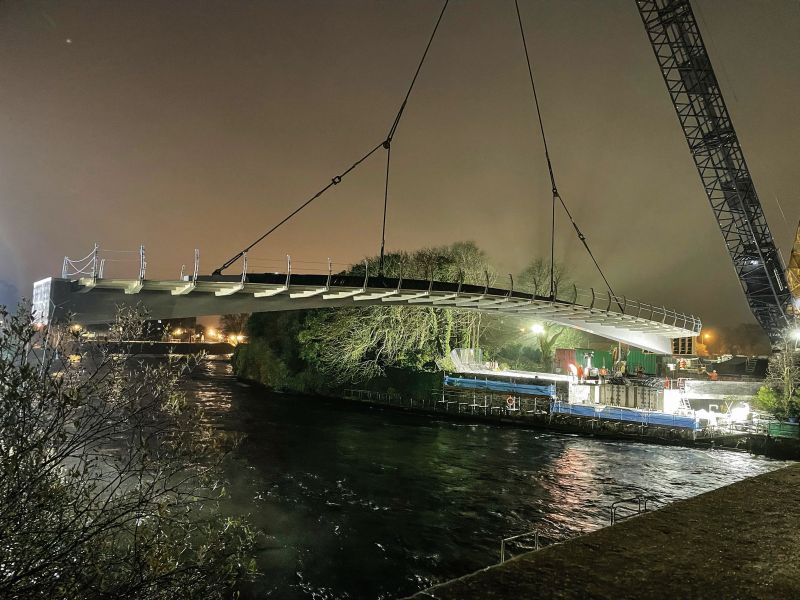CITY TRIBUNE
Covid-19 drives car sales slump in Galway

The Covid-19 pandemic has seen the sales of new cars and used imports in Galway slump by almost 80% over the past three months.
The coronavirus has also impacted the commercial sector, with the sale of small goods vehicles down 75% and the number of new HGVs drop to just two.
Between the beginning of April and the end of June this year, just 100 new cars were registered in Galway City and county – a massive drop of almost 79% from the 470 registered in the same period last year.
In fact, April saw a virtual collapse of the market in Galway, with just seven new cars registered – down more than 97% from 264 in April of 2019.
Data from the Society of the Irish Motor Industry (SIMI) also shows that secondhand imports in the second quarter of this year were down 78% to 331 (from 1,525).
Looking at the first half of the year, new cars recorded a 25.4% slump from 29,41 to 2,194 when compared to the same period last year.
This category of vehicles is called ‘new passenger vehicles’ and include cars, jeeps, people carriers and caravans.
The majority of the new registrations were diesel (49%); followed by petrol (30%); petrol electric (17%); electric (3%); petrol/plug-in hybrid (1%) and diesel electric (three vehicles).
Galway’s most popular new car so far this year is the Toyota Corolla (134 cars sold); followed by the Hyundai Tucson (87); Toyota Yaris (86); Ford Focus (82) and VW Tiguan (77).
The number of new Heavy Goods Vehicles (HGVs) registered in Galway in the second quarter of this year slumped by 93% – from 28 last year to just two. For the year to date, HGV sales dropped 47% from 66 to 35 here.
For Light Commercial Vehicles (small goods vans), there were 32 registered in the second quarter, down 75% from 128 in the same period last year. For the year to date, sales were down 30% from 549 to 383.
Meanwhile, the number of used cars being imported from the UK into Galway slumped by more than half during the first six months of the year (down 55% from 3,104 to 1,396).
As with new cars, the majority of the imports registered here were diesel (74%); followed by petrol (17%); petrol electric (5%); petrol/plug-in hybrid (3%); electric (five vehicles); diesel electric (three vehicles) and gas (one vehicle).
The most popular imports were jointly the Hyundai Tucson and Ford Focus (68 cars each); followed by the Audi A6 (66 cars); VW Golf (63) and Nissan Qashqai (56).
In recent years, used imports outsold the volume of new cars being registered in Galway, as motorists looked to the UK for bargains and high-end cars with specifications that may not have been available or affordable in the Irish marketplace.
Imports of used small goods vehicles in the first six months of the year were down 30% from 549 to 383, while heavy commercial vehicles were down 47% from 66 to 35.
CITY TRIBUNE
Galway ‘masterplan’ needed to tackle housing and transport crises

From the Galway City Tribune – An impassioned plea for a ‘masterplan’ that would guide Galway City into the future has been made in the Dáil. Galway West TD Catherine Connolly stated this week that there needed to be an all-inclusive approach with “vision and leadership” in order to build a sustainable city.
Deputy Connolly spoke at length at the crisis surrounding traffic and housing in Galway city and said that not all of the blame could be laid at the door of the local authority.
She said that her preference would be the provision of light rail as the main form of public transport, but that this would have to be driven by the government.
“I sat on the local council for 17 years and despaired at all of the solutions going down one road, metaphorically and literally. In 2005 we put Park & Ride into the development plan, but that has not been rolled out. A 2016 transport strategy was outdated at the time and still has not been updated.
“Due to the housing crisis in the city, a task force was set up in 2019. Not a single report or analysis has been published on the cause of the crisis,” added Deputy Connolly.
She then referred to a report from the Land Development Agency (LDA) that identified lands suitable for the provision of housing. But she said that two-thirds of these had significant problems and a large portion was in Merlin Park University Hospital which, she said, would never have housing built on it.
In response, Minister Simon Harris spoke of the continuing job investment in the city and also in higher education, which is his portfolio.
But turning his attention to traffic congestion, he accepted that there were “real issues” when it came to transport, mobility and accessibility around Galway.
“We share the view that we need a Park & Ride facility and I understand there are also Bus Connects plans.
“I also suggest that the City Council reflect on her comments. I am proud to be in a Government that is providing unparalleled levels of investment to local authorities and unparalleled opportunities for local authorities to draw down,” he said.
Then Minister Harris referred to the controversial Galway City Outer Ring Road which he said was “struck down by An Bord Pleanála”, despite a lot of energy having been put into that project.
However, Deputy Connolly picked up on this and pointed out that An Bord Pleanála did not say ‘No’ to the ring road.
“The High Court said ‘No’ to the ring road because An Bord Pleanála acknowledged it failed utterly to consider climate change and our climate change obligations.
“That tells us something about An Bord Pleanála and the management that submitted such a plan.”
In the end, Minister Harris agreed that there needed to be a masterplan for Galway City.
“I suggest it is for the local authority to come up with a vision and then work with the Government to try to fund and implement that.”
CITY TRIBUNE
Official opening of Galway’s new pedestrian and cycle bridge

The new Salmon Weir pedestrian and cycle bridge will be officially opened to the public next Friday, May 26.
Work on the €10 million bridge got underway in April 2022, before the main structure was hoisted into place in early December.
A lunchtime tape-cutting ceremony will take place on Friday, as the first pedestrians and cyclists traverse the as-yet-unnamed bridge.
The Chief Executive of Galway City Council, Brendan McGrath, previously said the bridge, once opened, would remove existing conflicts between pedestrians, cyclists and traffic “as well as facilitating the Cross-City Link public transport corridor over the existing 200-year-old bridge”.
The naming of the new bridge has been under discussion by the Council’s Civic Commemorations Committee since late last year.
One name that has been in the mix for some time is that of the first woman in Europe to graduate with an engineering degree – Alice Perry.
Ms Perry, who was from Wellpark, graduated from Queen’s College Galway (now University of Galway) in 1906. The university’s engineering building is named in her honour.
The bridge was built by Jons Civil Engineering firm in County Meath and was assembled off-site before being transported to Galway. Funding for the project was provided in full by the National Transport Authority and the European Regional Development Fund.
(Photo: Sheila Gallagher captured the city’s new pedestrian footbridge being raised on the south side of the Salmon Weir Bridge in December. It will officially open next Friday, May 26).
CITY TRIBUNE
Minister branded ‘a disgrace’ for reversing land rezoning in Galway City

From the Galway City Tribune – Minister of State for Local Government and Planning, Kieran O’Donnell was labelled a “disgrace” for overturning councillors’ decisions to rezone land in the new City Development Plan.
Minister O’Donnell (pictured) confirmed in a letter to Council Chief Executive Brendan McGrath last week that he was reversing 25 material alternations made by councillors to the CDP 2023-29. He made the decision on the advice of Office of Planning Regulator (OPR).
Minister O’Donnell directed that 14 land parcels that were subject to land-use zoning changes by councillors as part of the Material Alterations to the Draft CDP should be reversed.
He directed that a further 11 land parcels in the city should become “unzoned”.
The Minister found that the CDP had not been made in a manner consistent with recommendations of the OPR, which required specific changes to the plan to ensure consistency with the national planning laws and guidelines.
At last week’s Council meeting Cllr Eddie Hoare (FG) asked for clarity on the process by which councillors could rezone the lands that had been changed by the Minister’s direction.
Cllr Declan McDonnell said, “What he [Minister O’Donnell] has done is an absolute disgrace”.
And he asked: “Do we have to have another development plan meeting to deal with it?”
Both Cllrs Hoare and McDonnell wondered what would become of the lands that were rezoned or unzoned by the ministerial direction.
Mr McGrath said the Council had put forward an argument in favour of retaining the material alterations in the plan, but ultimately the Minister sided with OPR.
He said if councillors want to make alterations to the new plan, they could go through the process of making a material alteration but this was lengthy.
The Save Roscam Peninsula campaign welcomed the Minister’s decision.
In a statement to the Galway City Tribune, it said the direction would mean the Roscam village area on the Roscam Peninsula will be unzoned and a number of land parcels would revert back to agriculture/high amenity.
A spokesperson for the campaign said: “the material alterations made by city councillors following lobbying by developers continued the long-standing practice of councillors facilitating a developer-led plan rather than an evidence- and policy-based plan that meets the needs of the city.
“The Minister’s direction is an important step in restoring confidence in the planning system. It is clear from the City Council’s own evidence on future housing projections that there was no requirement to zone these lands for residential purposes in order to meet the needs of the targeted population increase up to 2029,” the spokesperson added.















